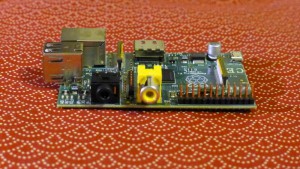I’m just going to blog a bit about my experience with Raspberry Pi.
What is it?
First off, if you don’t know what it is, Raspberry Pi is a cheap, tiny computer. It’s sold for $25/$35. It was originally developed for educational purposes, but due to its low price it has become sought after by hackers.
It’s about the size of a credit card and can be plugged into a regular TV. Instead of a hard drive or flash drive, it uses an SD card for its storage. It has two USB ports so that you can plug in a keyboard and a mouse.
It has only been generally available to the public since March 2012 and I finally got mine in the mail yesterday. Technically, it was delivered by DHL, which is a cheap delivery company. DHL is so cheap that if you’re not home when they deliver, they will send your package back to the sender. You have to be home, otherwise after a few attempts they will give the package back to the sender. They don’t have a public-facing location that you can just drive to like FedEx and UPS, so be warned.
Getting everything ready
Anyway, I had everything I needed to use my Raspberry Pi, so I started by reading the Quick Start Guide. After getting all your keyboard, mouse, SD card, and cables ready, you will need to download the OS image here: http://www.raspberrypi.org/downloads I used a torrent, verified the download sha-1 hash and then followed the instructions on this page to write it out to a blank SD card.
Raspberry Pi is powered via micro USB connector. This is similar to what a lot of modern cameras and cell phones might use. The Raspberry Pi page says specifically not to plug in the device into a PC, but after doing some research online, a lot of people had good results, so I chanced it. I had a micro USB cable from my Samsung Focus phone, so I used that.
The moment of truth
I plugged in the SD card, the keyboard, mouse, and then composite out into my TV. After that, I plugged the USB cable into my PC for power, and lo and behold it started booting up… And then–kernel panic. Apparently, I need to update my firmware. So now I’m off to download another copy of Debian Linux from here: http://www.raspberrypi.org/archives/1435. Hopefully this one works.
